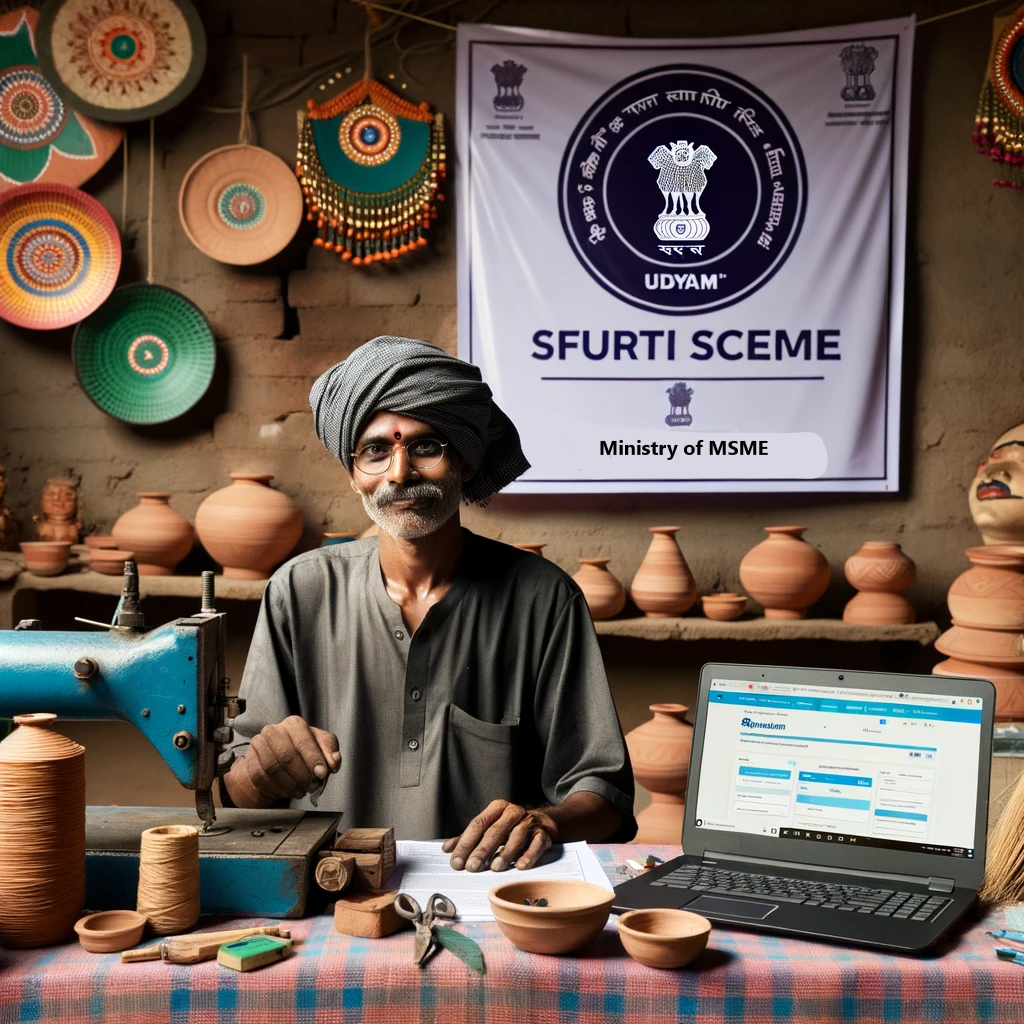Boosting 'Make in India': The Remarkable Impact of SFURTI Scheme

The SFURTI plan is an initiative launched by the Ministry of MSME of the Indian government to foster cluster development in India. The scheme was introduced in 2005 and is still in use today.
The initiative is centered on the local working class and Indian enterprises engaged in traditional industries. This strategy provides individuals with substantial economic benefits as well as assistance in greatly enriching their lives.
Let us learn about the SFURTI scheme, its benefits, how to apply, and who is eligible for it.
What is the SFURTI Scheme?
SFURTI stands for Scheme of Fund for Regeneration of Traditional Industries. The SFURTI plan was introduced in 2005 by the Ministry of MSME of the Indian government to stimulate the growth of clusters in India.
The major goal of the SFURTI project is to provide facilities and benefits to the many traditional clusters of businesses dispersed across India, allowing them to become more competitive in the industry and earn higher profits.
These traditional sectors employ a major proportion of India's workforce, and the initiative aims to help them boost productivity and become financially feasible. The program enables this by locating CFCs, or Common Facility Centers, near the industry and creating job possibilities.
The strategy focuses on various major industries, including the bamboo, honey, and khadi industries. This benefits traditional artisans, local workers, and local entrepreneurs by significantly supporting their businesses.
The scheme intends to achieve several key objectives:
- Organizing different groups of traditional industry workers and craftsmen to ensure their competitiveness and to facilitate support and aid for their livelihood.
- Providing long-term economic stability for the industry's different workers, local business owners, and rural craftspeople.
- Increasing the market value and advertising value of products offered by local clusters. This is accomplished by giving economic and financial support for the worker's or artisan's new items, intervening in and correcting the design process, improving product packaging, and assuring a solid marketing plan for the product.
Benefits of the SFURTI Scheme:
There are several major benefits to the SFURTI plan that every beneficiary who uses it should be aware of.
- The plan assists local and traditional craftsmen in rural India in the various linked clusters to enhance their skills and production capacities, allowing them to find better work and achieve economic success. This is accomplished through specialized training and a series of exposure visits.
- The SFURTI program provides genuine provisions for both facilities and centers. It gives artisans and workers a better set of equipment tools to help them improve the quality of their products and services. Indirectly, the plan ensures that the numerous facilities accessible to an artisan are used to their full potential.
- Stakeholders actively participate in the cluster-governing system. These stakeholders actively seek market possibilities in these clusters, ensuring the respective clusters' economic growth.
- The scheme promotes cluster-based industries in a district's sub-divisional regions. This assists local workers and rural artisans in developing useful and innovative skills that assist them in developing new business ideas, improving the technologies involved, upgrading the quality of processes, and providing workers with a feeling of market intelligence that assists them in developing new marketing partnerships.
- The scheme contributes to the development of an economically sustainable company environment that offers a diverse range of products with its own integrated value chain. The initiative also takes a market-driven approach to developing products and services that will secure the long-term viability of cluster-based industries.
- The strategy ensures the integration of various artisans and workers in the clusters to develop united operations and company formations that assist overall regional progress.
- The program assists artisans and workers in developing and marketing items that are aimed at and meet the needs of the present consumer market. This enables them to integrate their otherwise unorganized product lines into an overall product line that is unified with the cluster's whole artisan force in order to generate items with the greatest value.
- The strategy considers E-commerce as one of the best business avenues for business growth and marketing for presenting local artists' businesses and products to a larger market. The project creates a rigorous plan to ensure that local artisans' products and services become well-known and renowned in the E-commerce industry's online domain.
What Industries are Covered by the SFURTI Scheme?
The SFURTI plan applies to a wide range of enterprises, sectors, and individuals. These are as follows:
- Artisans
- Cooperatives of artisan guilds
- Workers
- Suppliers of raw materials
- Local business owners
- Providers of PDS
- SHGs (Self-Help Groups)
- Manufacturers of machinery
The SFURTI Scheme Application Procedure:
If you want to apply for the SFURTI program and acquire a loan for your business, service, or products, you must first complete and submit a proposal to your region's State Office and KVIC. The plan and request are then thoroughly reviewed and vetted for integrity by State and Zonal level offices.
If the document passes its authenticity verification, it is finally delivered to the Scheme Steering Committee for final approval. The loan is issued to the user after approval.
Eligibility for SFURTI Scheme:
Choosing which clusters to select is an important aspect of the SFURTI scheme's eligibility process. These clusters are chosen primarily for their geographical concentration inside or near a revenue sub-divisional region in the district. In the sub-divisional area, the concentration should be roughly 500 benefit families or persons who are craftsmen, entrepreneurs, raw material suppliers, local service providers, and so on.
The chosen clusters originate from a variety of businesses, including but not limited to khadi, coir, and village, as well as leather and ceramics. The initiative will closely monitor production growth and job prospects inside these clusters. Furthermore, clusters from Northeastern regions such as Assam, Sikkim, Nagaland, and others must have at least a 10% distribution in the total consideration for the plan while picking appropriate clusters.
Conclusion:
The SFURTI scheme stands out as a crucial initiative for India's local working class, providing indispensable support to those facing economic challenges in establishing and sustaining their businesses. We trust that this article has offered valuable insights into the various facets of the program. For the latest updates on initiatives impacting local businesses, we invite you to stay connected with "AceHours". Your ongoing support enables us to continue sharing information that empowers and uplifts the entrepreneurial spirit within our communities.




